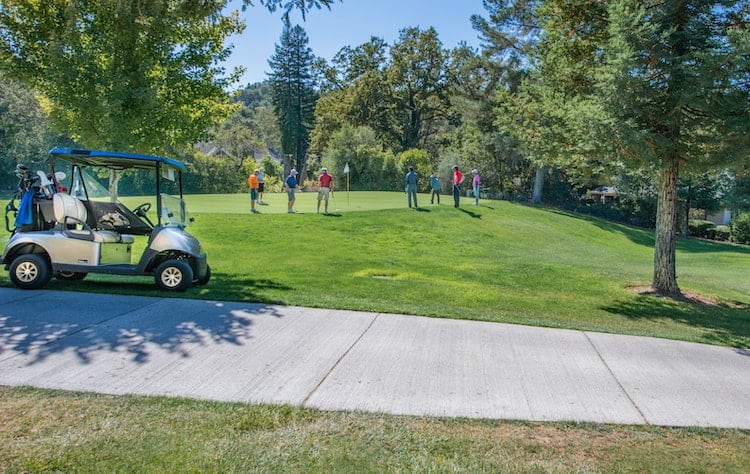
If you are as impatient as me, you will understand the pain of finishing your round at 3:15 pm and having to wait around for two hours for the rest of the competitors to finish. Fortunately, there is a logical solution: the shotgun start.
Late last summer, I played in my first shotgun golf tournament in a decade, and, after an enjoyable day out, I wondered why there are not more of these events.
l will take you through how it works and explain the benefits, to raise awareness for this forgotten setup. My aim is to have you begging tournament organizers to arrange more shotgun starts.
What is a Shotgun Start in Golf?
A shotgun start golf tournament format sees the first to 18th group of four balls tee off, at the same time on different holes. In other words, each four-ball is assigned a different hole from the 1st to the 18th, and you tee off at a specific time.
Before I give you an example of how it works, it is only fair to touch on the origins of a shotgun tournament. In the book Now You Know Golf, author Doug Lennox cites Walla Walla Country Club Professional Jim Russell as the creator of this format.
In May 1956, Russel was rumored to have fired a shotgun off as a starting signal for entrants waiting on tee boxes around the golf course.
Now, for an example of a shotgun tournament structure. If every four-ball is scheduled to tee off at 12 pm, golfers make their way to their assigned tee box and wait for the start of play. If you are programmed to start somewhere random like the 7th hole, you may consider a couple of golf carts for your group to speed up the process.
Once you are on the tee box and starters signal sounds, each player has their turn to tee off, and away you go. Every group plays a full round of 18-holes, which means if you tee off on the 11th hole, your 18th will be the tenth hole.
The only times that I have played in a shotgun start have been in charity tournaments, where an auction is scheduled after prize giving. Without a doubt, If you operate with the typical first tee and tenth block setup, golfers may leave before the auction, leading to a loss in potential revenue.
Instead, a shotgun start helps to maintain a consistent pace of play. The ultimate goal is for all entrants to finish at the same time.
On multiple occasions, the format was a shotgun scramble. That meant that we would choose the best shot of the group and play our own ball from that position. In addition, these tournaments were typically betterball or best ball stableford.
After each hole, we recorded the two lowest scores. At the end of the round, we added the two best from each hole together. That gave us a total team score. These tournaments almost always included the longest drive and closest to the pin challenge.
Other Variations of The Shotgun Start
Reverse Shotgun Start
A reverse shotgun start is employed in smaller tournaments with fewer participants. The organizers set down tee times for the 18th and back. For example, there are forty players in a competition, totaling ten four balls.
The tournament organizers assign the first group to the 18th and the second group to the 17th until we reach group ten on the ninth tee.
The purpose of a reverse shotgun start is to free up the first tee as quickly as possible to enable other paying clientele to get an 18-hole round in.
Modified Shotgun Start
A modified shotgun start follows the same premise as a reverse setup and is designed for tournaments with fewer entrants. The organizers set up the tee system to not interfere with other paying customers’ rounds.
For instance, they may start tournament entrants off on the second to the ninth hole so that the first and tenth tees are free for others to start from.
Double Shotgun Start
A double shotgun start occurs when there are more than 72-golfers on the tee sheet. 72 divided by four gives you 18 fourballs – enough for each hole. When there are more than 72-players, you need to adjust the schedule to fit them in.
Tournament organizers may offer a morning or afternoon tee time and run two sets of shotgun starts. That makes the most sense if you have over one hundred players on the tee sheet. Therefore group A tees off the fourth hole at 7am, and B commences at 11:15am.
The challenge with that setup is that you rely on the morning field to return to the event for the prize-giving and auction proceedings.
An alternative option is to add two groups of four to each of the par 5 holes. If the proposed tournament start time is 12pm, Group A tees off at 12pm, and group B follows once A is out of sight.
Related: How to Play Golf: The Ultimate Beginner’s Guide

